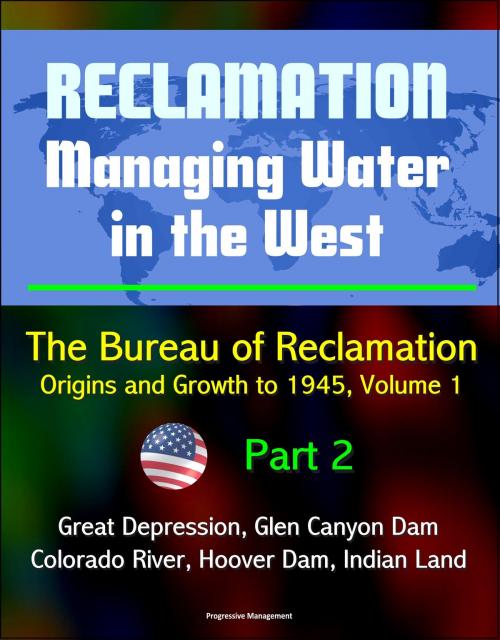Reclamation: Managing Water in the West - The Bureau of Reclamation: Origins and Growth to 1945, Volume 1 - Part 2 - Great Depression, Glen Canyon Dam, Colorado River, Hoover Dam, Indian Land
Nonfiction, Science & Nature, Technology, Engineering, Civil| Author: | Progressive Management | ISBN: | 9781311226570 |
| Publisher: | Progressive Management | Publication: | November 14, 2014 |
| Imprint: | Smashwords Edition | Language: | English |
| Author: | Progressive Management |
| ISBN: | 9781311226570 |
| Publisher: | Progressive Management |
| Publication: | November 14, 2014 |
| Imprint: | Smashwords Edition |
| Language: | English |
The Bureau of Reclamation has a grand tradition, and this volume tells the fascinating story of that tradition from Reclamation's beginnings to the end of World War II. The story of Reclamation is deeply entwined in the development of the American West in the twentieth century and beyond. Reclamation was established in 1902 by President Theodore Roosevelt to "make the desert bloom." Reclamation projects have been the seed for many of the modern American West's large agricultural and metropolitan centers. The Columbia Basin of Washington, the Central Valley of California, the Central Arizona Project, and the Shoshone and Platte River Projects areas of Wyoming are just a few of the many irrigated areas that are vital parts of the economic backbone of the West. Boise, Spokane, Las Vegas, Casper, and El Paso are some of the Western cities that have grown up around Reclamation projects.
Today, Reclamation provides one out of five western farmers with water for 10 million irrigated farmland acres.
CHAPTER 1: ACHIEVEMENTS AND ACHIEVERS * CHAPTER 2: VISIONS OF NATIONAL RECLAMATION * CHAPTER 3: NATIONAL RECLAMATION BEGINS * CHAPTER 4: LIMITS * CHAPTER 5: CHARTING A NEW FUTURE * CHAPTER 6: THE BUREAU OF RECLAMATION AND THE GREAT DEPRESSION * CHAPTER 7: THE MANY FACES OF RECLAMATION * * CHAPTER 1: ACHIEVEMENTS AND ACHIEVERS * The Salt River Valley: An Early Success * California: From the Colorado River to the Central Valley Project * Beyond California: The Grand Coulee of the Pacific Northwest * The Colorado-Big Thompson Project (C-BT) * The Achievers: * The Newell Era * Commissioner Elwood Mead * Dominy's Drive and Energy * Adjustments for a Different Future * Endnotes * CHAPTER 2: VISIONS OF NATIONAL RECLAMATION * Introduction * The Agrarian Myth in an Imperfect Land * Internal Improvements and Other Arguments * The West as Problem * Other Issues * Advice * Misconceptions * A Troubled Survey * Desperation and Disparate Voices * New Frontiers: Rural and Urban * The Publicists * The Outcome * Endnotes * CHAPTER 3: NATIONAL RECLAMATION BEGINS * Introduction * Breaking Political Barriers to National Reclamation * Reclamation and the Disposal of the Public Domain * Competitive Bureaucracies and Personalities * The Reclamation Act: Its Breadth, and Struggle with Western Water Laws * Visions of Rural Life Reinforce the Enterprise of Reclamation * Building the Projects, Physically, Administratively, and Socially * In Defense of the Early Years * Putting Idealism to Work on the Land (Including Indian Land) * Question of Law * Of Dams and Hydroelectricity * Immediate Issues and Criticisms * Endnotes * CHAPTER 4: LIMITS * Introduction * Sober Reflections and Times * A New Secretary of the Interior, Project Issues, Newell's Eclipse * Repayment Problems Continue * Extension Acts and Faith in Agriculture * Problems of Land and Water * Currents of Change against the Background of War * The War and Reclamation * Interwar Realities * Endnotes * CHAPTER 5: CHARTING A NEW FUTURE * Introduction * Mead Takes the Helm * Beyond the Fact Finders' Report: The Colorado Question * The Colorado River and Southern California * Hurdles for the Boulder Canyon Legislation * Mead's Continuing Challenges * Mead's Mission to Revive Reclamation * Pondering Dam Design and New Projects in an Era of Constraints * Rivalries Within Government * Reclamation Seeks a Western and Southern Strategy * The Way to Boulder Canyon * The Bureau of Reclamation Wins with the Boulder Canyon Project * Hoover Dam: Symbol of an Era * Endnotes * CHAPTER 6: THE BUREAU OF RECLAMATION AND THE GREAT DEPRESSION * Introduction * Facing the Crisis of the Great Depression * Resettlement Issues * New Agendas * The Bureau of Reclamation on the Columbia River * Reshaping California's Water Landscape * Restructuring Nature * The Colorado-Big Thompson Project * Transitions and Ambivalence * A Land to be Redeemed * Altogether an Ambitious Decade * Shrinking Vistas on the Land
The Bureau of Reclamation has a grand tradition, and this volume tells the fascinating story of that tradition from Reclamation's beginnings to the end of World War II. The story of Reclamation is deeply entwined in the development of the American West in the twentieth century and beyond. Reclamation was established in 1902 by President Theodore Roosevelt to "make the desert bloom." Reclamation projects have been the seed for many of the modern American West's large agricultural and metropolitan centers. The Columbia Basin of Washington, the Central Valley of California, the Central Arizona Project, and the Shoshone and Platte River Projects areas of Wyoming are just a few of the many irrigated areas that are vital parts of the economic backbone of the West. Boise, Spokane, Las Vegas, Casper, and El Paso are some of the Western cities that have grown up around Reclamation projects.
Today, Reclamation provides one out of five western farmers with water for 10 million irrigated farmland acres.
CHAPTER 1: ACHIEVEMENTS AND ACHIEVERS * CHAPTER 2: VISIONS OF NATIONAL RECLAMATION * CHAPTER 3: NATIONAL RECLAMATION BEGINS * CHAPTER 4: LIMITS * CHAPTER 5: CHARTING A NEW FUTURE * CHAPTER 6: THE BUREAU OF RECLAMATION AND THE GREAT DEPRESSION * CHAPTER 7: THE MANY FACES OF RECLAMATION * * CHAPTER 1: ACHIEVEMENTS AND ACHIEVERS * The Salt River Valley: An Early Success * California: From the Colorado River to the Central Valley Project * Beyond California: The Grand Coulee of the Pacific Northwest * The Colorado-Big Thompson Project (C-BT) * The Achievers: * The Newell Era * Commissioner Elwood Mead * Dominy's Drive and Energy * Adjustments for a Different Future * Endnotes * CHAPTER 2: VISIONS OF NATIONAL RECLAMATION * Introduction * The Agrarian Myth in an Imperfect Land * Internal Improvements and Other Arguments * The West as Problem * Other Issues * Advice * Misconceptions * A Troubled Survey * Desperation and Disparate Voices * New Frontiers: Rural and Urban * The Publicists * The Outcome * Endnotes * CHAPTER 3: NATIONAL RECLAMATION BEGINS * Introduction * Breaking Political Barriers to National Reclamation * Reclamation and the Disposal of the Public Domain * Competitive Bureaucracies and Personalities * The Reclamation Act: Its Breadth, and Struggle with Western Water Laws * Visions of Rural Life Reinforce the Enterprise of Reclamation * Building the Projects, Physically, Administratively, and Socially * In Defense of the Early Years * Putting Idealism to Work on the Land (Including Indian Land) * Question of Law * Of Dams and Hydroelectricity * Immediate Issues and Criticisms * Endnotes * CHAPTER 4: LIMITS * Introduction * Sober Reflections and Times * A New Secretary of the Interior, Project Issues, Newell's Eclipse * Repayment Problems Continue * Extension Acts and Faith in Agriculture * Problems of Land and Water * Currents of Change against the Background of War * The War and Reclamation * Interwar Realities * Endnotes * CHAPTER 5: CHARTING A NEW FUTURE * Introduction * Mead Takes the Helm * Beyond the Fact Finders' Report: The Colorado Question * The Colorado River and Southern California * Hurdles for the Boulder Canyon Legislation * Mead's Continuing Challenges * Mead's Mission to Revive Reclamation * Pondering Dam Design and New Projects in an Era of Constraints * Rivalries Within Government * Reclamation Seeks a Western and Southern Strategy * The Way to Boulder Canyon * The Bureau of Reclamation Wins with the Boulder Canyon Project * Hoover Dam: Symbol of an Era * Endnotes * CHAPTER 6: THE BUREAU OF RECLAMATION AND THE GREAT DEPRESSION * Introduction * Facing the Crisis of the Great Depression * Resettlement Issues * New Agendas * The Bureau of Reclamation on the Columbia River * Reshaping California's Water Landscape * Restructuring Nature * The Colorado-Big Thompson Project * Transitions and Ambivalence * A Land to be Redeemed * Altogether an Ambitious Decade * Shrinking Vistas on the Land















